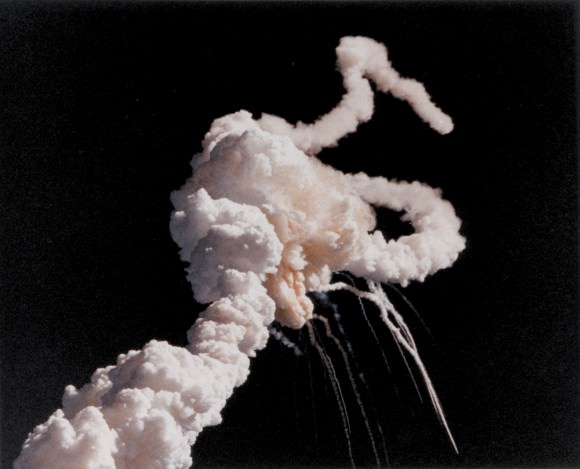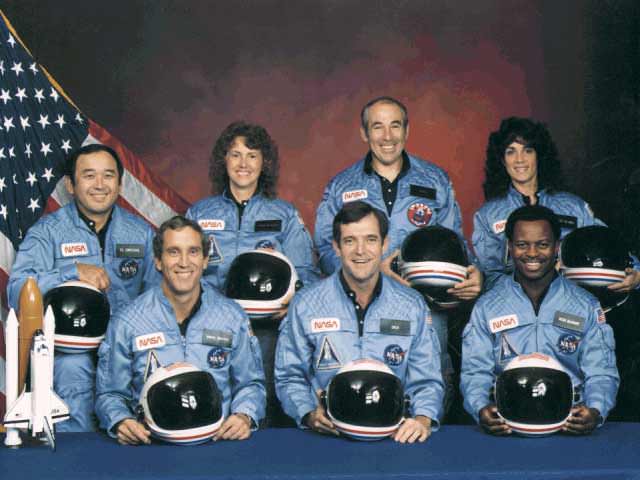It was on this day (Jan. 28) in 1986 that stunned viewers across the world saw the Challenger space shuttle explode on television. The broadcast (you can see CNN’s above) was being carried all over the place because the crew included the first teacher in space, Christa McAuliffe. The planned six-day mission, however, lasted just over a minute before catastrophe occurred.
Flying aboard mission 51-L were commander Francis “Dick” Scobee, pilot Michael Smith, mission specialists Judith Resnik, Ellison Onizuka and Ronald McNair, and payload specialists Gregory Jarvis and McAuliffe. The physical cause of the explosion was traced back to a faulty O-ring on one of the shuttle’s external boosters, which weakened in the cold before launch and then failed, leading to the explosion about 72 seconds after launch.
Other factors were cited as well by journalists and the Rogers Commission, such as NASA’s desire to keep to what outsiders said was an unrealistic, quick-moving launch schedule that saw shuttles leave the ground every few weeks to carry commercial and military payloads. NASA and contractor Morton Thiokol made changes to the boosters, and NASA further changed the flight rules and other procedures in response to the disaster.
There are many memorials to the fallen crew, but one of the most cited in education is the 40 Challenger Learning Centers that are located in the United States, Canada, United Kingdom and South Korea. The network was founded by June Scobee Rogers (the widow of commander Scobee) and includes participation from other Challenger family members. Their goal is to “give students the chance to become astronauts and engineers and solve real-world problems as they share the thrill of discovery on missions through the Solar System,” the website states.
Challenger’s anniversary comes in a week that includes other tragic anniversaries, including the Apollo 1 pad fire that claimed three astronauts’ lives (Jan. 27, 1967) and Columbia shuttle breakup that killed seven (Feb. 1, 2003). Other astronauts have died in training accidents; you can see a list at the Astronaut Memorial Foundation. Additionally, four cosmonauts died in spaceflight: Vladimir Komarov (Soyuz 1 on April 24, 1967) and Georgi Dobrovolskiy, Viktor Patsayev, and Vladislav Volkov (Soyuz 11 on June 30, 1971).



Has anyone here ever read Feynman’s appendix?
Puts a whole new perspective on, “$2 billion a year whether it flies, or not”.
Since 1971, only NASA has killed astronauts! ALL 14 astronauts world wide killed since then died on the space shuttle.
It was simply a bad idea to do 134 manned launches to LEO. There couldn’t have been that many payloads which really needed crew onboard to make them happen. It seems irrational to always mix crew with payload. 2 failures out of 134 is a very good record for a payload launcher. However, it is not good for a seven-manned launcher! And it destroyed 2 out of 4 reusable launchers, so it wasn’t even a good record for the recoverable vehicle concept as such, even if it had been unmanned. 50% destruction of capacity.
Well, it’s gone now and no astronaut has died since. Things are looking up!
I was around at the time and do not recall many people saying that the shuttle was a bad idea. That only became obvious with hindsight. According to the projections, a manned reusable vehicle looked like a reasonable way to take large payloads into space compared to the single-use rockets of the day. Of course the projections were hopelessly optimistic, as were the estimates of how safe it was. We know that now, and 40 years of engineering has cut the cost of single-use rockets quite a bit.
The SLS isn’t often accused for being cheap and quick to develop thanks to its better engineering reuse of the space shuttle components. Seems like maybe purpose, commercial or visionary, is much more important for the cost equation. Better engineering might be used purposefully, but without mission there’s no need to do that.
If one wants to launch 1000 astronauts to LEO, then 4 space shuttles were good, they did it. But if one wants to travel through space instead of swimming in it at lowest possible orbit for 40 years, then it didn’t quite do the trick.